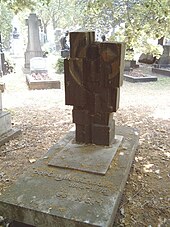Sándor Bortnyik
Sándor Bortnyik , also Alexander [ ˈʃaːndor ˈbortɲik ] (born July 3, 1893 in Marosvásárhely , Austria-Hungary , † December 31, 1976 in Budapest ) was a Hungarian modern painter and graphic artist .
Life
In 1910 Bortnyik studied at the free art school in Budapest with Károly Kernstok , József Rippl-Rónai and János Vaszary . His contacts with the magazine “A Tett” (Die Tat) lead to the acquaintance of Lajos Kassák , Janos Mattis Teutsch, Gyula Derkovits and Béla Uitz. Through them he found the group “MA” (Today) in 1917 and became one of the most important representatives. Above all, German Expressionism and French Cubism influence him. In 1919, after the fall of the Soviet Republic , Bortnyik emigrated to Vienna, where he published the portfolio “Bildarchitektur”, a series of 6 constructivist stencil prints. This series leads from the letter and number fragments over to the program of a fictional construction of reality. The composition consists of pure colors and interlinked geometric shapes. They seem like sterile ideas of the new creation of harmony dreamed on paper. On the basis of this work, which is regarded as one of the incunabula of early constructivist graphics, Kassák developed his “pictorial architecture theory”. In 1922 there was a break with Lajos Kassák , editor-in-chief of the magazine “MA”. Bortnyik then published in other Hungarian émigré magazines and became editor of the magazine “Kritika” (criticism). At this time, his works show a figurative expressionism with rayonistic and cubo-futuristic elements. At the end of 1922, Bortnyik exhibited for the first time in Herwarth Walden's Berlin gallery Der Sturm .
At the invitation of Farkas Molnár, Bortnyik travels to Weimar and takes part in the congress of Dadaists and Constructivists. He stayed in Weimar for a few years to observe work at the Bauhaus . He attends Theo van Doesburg's “ De Stijl ” course and is interested in Oskar Schlemmer's theater workshop . In Weimar, Bortnyik paints abstract spatial compositions with surreal figures that are reminiscent of the later metaphysical painting by Giorgio de Chirico ( the new Adam , the new Eve 1923). The geometric compositions show his rather distant ironic attitude towards the Bauhaus. In 1923, Bortnyik's own exhibition was opened in the Nierendorf gallery in Berlin . In 1926 Sandor Bortnyik returned to Budapest and worked on the avant-garde theater “Zöld Szamár” (Green Donkey).
In 1928, Bortnyik founded the school for advertising graphics "Mühely" (workshop) based on the example of the Weimar Bauhaus , which he directed until 1938 and at which Victor Vasarely also studied. Within the private school, Bortnyik wanted to put into practice those principles that he got to know in Weimar: functional design, the union of construction and composition, as well as the use of modern typography and photographic art. After his return from emigration, Bortnyik soon became the leading figure in Hungarian advertising graphics. In his posters, the abstract constructivist image design and the repertoire of forms of the "New Typography" combined with an unorthodox color palette come into play. Bortnyik's poster style remains flat and often shadowless.
Several pictorial principles dominated until 1930. On the one hand, with a strictly diagonal structure, one sees the doubling or multiple repetition of figures. The sequence as a design means, an immanent principle of industrial mass production, was generally highly valued by the constructivists, and it was also widespread in commercial graphics . Another pictorial process in Bortnyik's posters, which became common around 1925, was the combination of a detailed reproduction of the packaging and a schematic, stylized figure that appears to have been cut out of the smooth, monochrome background.
The essential thing about Bortnyik's posters is always the goods, everything else is subordinate to this principle. In particular, the poster designs for “Modiano” from 1926 show Bortnyik's extremely fine sense of color and shape very well. They are prime examples of constructivist advertising art . All of the maxims accumulate in them: objectivity, dynamism, economical use of resources, imagery.
In 1929 the picture book Die Wunderfahrt with verses by Albert Sixtus , which is still widely regarded today, is published by Alfred Hahn's Verlag Leipzig. The Manuscriptum-Verlag publishes a new edition in 2002.
Over time, an increasing aestheticization of the goods can be observed on the posters. Not least thanks to Bortnyik's work, Budapest was regarded as an important center of avant-garde poster art during these years. After the Second World War, Bortnyik's art was based on a sometimes satirical Socialist Realism . From 1948 to 1949 he was a teacher at the University of Applied Arts and then until 1959 director of the University of Fine Arts in Budapest.
At the end of his life he finds his way back to the art of earlier years.
Museums
Bortnyik's work is represented in numerous exhibitions on the Hungarian avant-garde and well-known collections, for example
- Hungarian National Gallery - Budapest
- Jannus Pannonius Museum, Pecs , Hungary
- Museum Abteiberg , Mönchengladbach
- Thyssen-Bornemisza Museum , Madrid
- Los Angeles County Museum of Art - LACMA, USA
literature
- Eckhard Neumann (ed.): Bauhaus and Bauhäusler: Memories and Confessions . Extended new edition 1985, Cologne: DuMont, 1996 ISBN 3-7701-1673-9 , pp. 144-149
Web links
- Literature by and about Sándor Bortnyik in the catalog of the German National Library
- Fine Arts in Hungary - Sándor Bortnyik
| personal data | |
|---|---|
| SURNAME | Bortnyik, Sándor |
| ALTERNATIVE NAMES | Bortnyik, Alexander |
| BRIEF DESCRIPTION | Hungarian painter and printmaker |
| DATE OF BIRTH | July 3, 1893 |
| PLACE OF BIRTH | Marosvásárhely , Austria-Hungary |
| DATE OF DEATH | December 31, 1976 |
| Place of death | Budapest |
